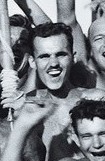GALVIN-DANIEL
DANIEL TERRY GALVIN

LT

THE DAY OF LIBERATION FROM
JAPANESE POW CAMP OMORI
AUGUST 29, 1945
Camp Omori was on a man-made island in Tokyo Bay and housed nearly 600 POWs by the end of World War II. Near the end of the war rumors were rampant as most of the prisoners speculated that when Americans got close, the guards would gather them and gun them down. By the summer of 1945 there was little doubt the Americans were now very close because of the intensity of nearby air strikes. Treatment at the camp was horrific as all able-bodied prisoners were made to work at nearby docks and warehouses. Beatings, sickness, and barely edible food led to the death of many of Omori’s prisoners.
Suddenly, on August 15, 1945, things drastically changed after the Japanese emperor announced the war was ending. Work details suddenly ceased, many of the guards abandoned their posts, and those who were left passed out clothes, vitamins, toilet paper, and more food than the startled captives had seen before. When American ships began to appear in Tokyo Bay on August 29, 1945, the prisoners were delirious with excitement as it seemed their death sentence had been lifted.
On August 29th the first American landing craft came close to Camp Omori as it was led by a torpedo bomber guiding it to the camp. As the landing craft approached, pandemonium broke out on the camp pier as prisoners rushed to the water’s edge. Approaching the pier, a Navy photographer snapped a picture and later wrote: “We finally spotted the moving figures on a pier jutting out to the bay. We came closer – they were screaming and yelling and waving their arms, their shirts, and an American flag. Some wore no clothing at all, some had G-strings, and others had on the remnants of what they were captured in, and a few had on new clothes that had been dropped by B-29s the last few days. Some started to swim for our boat and were told to go back. The others kept waving and shouting and we waved and shouted back, and tears came to my eyes.”
The photograph was widely published, and historians have searched the famous photo to establish identities. Only thirteen have been named which includes eleven Americans (US Army Air Force-6; USN-4, USMC-1) one from Holland, and one from South Africa.
Lieutenant Daniel Terry Galvin was one of the joyful POWs. He was the Navy pilot of a Curtiss SB2C Helldiver from the carrier USS Hornet that went missing on June 15. 1944. Historical records are scarce concerning him but do reveal that on June 15, 1944, he participated in an attack on Chichi Jima, an island off Japan that housed an important communications facility. Pilots dreaded Chichi Jima as its harbor was surrounded by anti-aircraft guns and was considered a tough, dirty target. LT Galvin failed to return to Hornet and the Hornet’s aircraft action report states, “LT Galvin was apparently hit by anti-aircraft fire as he was last seen in his dive.” LT Galvin and his gunner, Aviation Radioman Second Class Oscar Doyle Long, were in deed shot down and spent the next 14 months as POWs at Camp Omori. Following the war intelligence confirmed that POWs shot down at Chichi Jima were subjected to harsh treatment, some were purposely beheaded, and at least four American airmen were cannibalized as a senior Japanese officer believed that consumption of human liver had medical benefits. Fortunately, LT Galvin and ARM2 Long did not receive this fate. Daniel Terry Galvin died December 22, 1993, and is buried at Arlington National Cemetery.
OMORI POW CAMP, TOKYO BAY, JAPAN 1945
Submitted by CDR Roy A. Mosteller, USNR (Ret)


